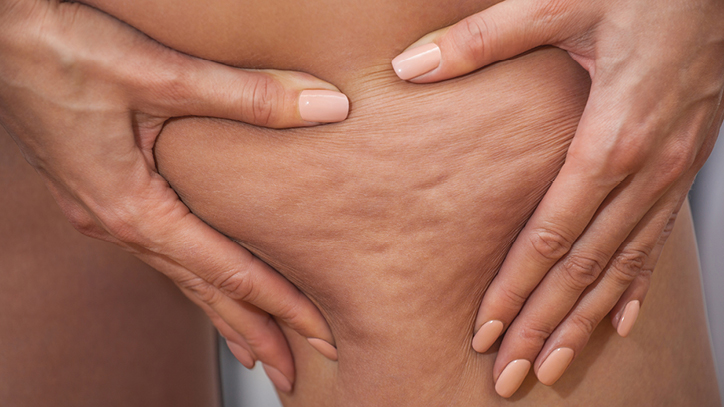
- United States
Get non-surgical solutions for today's top aesthetic concerns with Venus Treatments. Join thousands of satisfied patients worldwide!
- Loading...
- All Regions
Get non-surgical solutions for today's top aesthetic concerns with Venus Treatments. Join thousands of satisfied patients worldwide!

Cellulite is hard to beat. Despite focused diets, targeted exercises, and the best weight loss efforts, cellulite still manages to cling to the hips, buttocks, and thighs. But that isn’t true for all women. So why do some women get cellulite, while other women (and most men) don’t?
What really causes cellulite? The answer isn’t entirely straightforward, but a lot of it it has to do with a combination of factors that, unfortunately, make women’s bodies much more susceptible to cellulite. The first factor has to do with the collagen structure in most women’s thighs compared to most men. The variation largely comes down to differential hormonal levels—because men generally have significantly more testosterone than women, male collagen structure tends to be thicker and closer-knit, while the overall collagen structure in a female’s body looks more like a picket fence, with wider openings. The tighter collagen structure of male skin helps to maintain smoothness on the skin’s surface. Secondly, due to women’s generally higher levels of estrogen, female bodies tend to store more fat. Lastly, women have more alpha receptors, which use fat cells to create more fat. In combination, these factors make for the perfect cellulite-friendly trio, as more fat cells press against weaker collagen structures, causing dimpling on the skin’s surface.
But why do some women get cellulite while others don’t? For one, everyone’s body is unique. That means that different women have different hormone levels, and thus their collagen structure may be more or less inclined to show cellulite. Diet may also play a factor, as some processed and packaged foods can contain estrogen-mimicking ingredients that tend to promote the creation and storage of more fat in the body. Another factor may have to do with sedentary career and lifestyle choices. Desk jobs and television binges cause a decline in circulation in the legs, leading to decreased collagen production. This causes collagen structures to weaken, making way for cellulite. Finally, restrictive clothing choices may also come into play. The tighter the pants (or underwear) the greater the decline in circulation and collagen production, thereby boosting the risk of developing cellulite.
While genetics can also play a role, preventative measures like a healthy diet (including one without ingredients that might interfere with hormone levels), lots of exercise to improve circulation, and avoiding restrictive clothing can make a big difference.
Though some women appear to have cellulite and others do not, it’s important to remember that the latter may not be entirely true: cellulite comes in four grades, from zero to three, suggesting that even those women who don’t seem to have any cellulite may still have it — it’s just less visible.
The first grade of cellulite (beyond grade zero) is the least visible, with minor dimples looking a little bit like an orange peel. The second grade is what is often likened to cottage cheese in appearance and the skin is a little looser. The third grade may be described as appearing more like a mattress, with deeper dimples and lax skin.
For those seeking treatment for unwanted lumps and bumps, know that any successful treatment for cellulite must have a three-pronged approach to be effective:
Creams and liposuction treatments target the fat below the surface, but these treatments often neglect to boost collagen levels or circulation, meaning the remaining fat will cause cellulite to re-appear. To cover all the cellulite-fighting bases, consider a radio frequency-based treatment plan to effectively reduce its appearance. Using energy delivered below the skin’s surface via cutting-edge technology that combines radio frequency and electro magnetic fields, these treatments generate heat to melt away fat cells, while boosting skin’s natural collagen production levels and improving circulation.
To discover if cellulite reduction treatments are right for you, locate a certified treatment provider using the search field below.
Find a certified Venus Treatments provider near you today who specializes in today’s top aesthetic medical solutions.


Search below to find a provider near you and to learn about our non-surgical aesthetic treatments with ARTAS®, NeoGraft®, Venus Bliss™, Venus Bliss MAX™, Venus Versa™, Venus Legacy™, Venus Velocity™, Venus Viva™ MD, and Venus Glow™.
For more information call: (888) 907-0115 // [email protected] // 4001 SW 47th Ave, Suite 206, Davie, Florida, 33314
REGULATORY CLEARANCES [ More ]
Venus Bliss™ is cleared by the FDA for non-invasive lipolysis of the abdomen and flanks in individuals with a Body Mass Index (BMI) of 30 or less, with the diode laser applicators. The (MP)2 applicator is cleared by the FDA for temporary reduction in the appearance of cellulite.
Venus Versa™ is cleared by the FDA as a multi-application device intended to be used in aesthetic and cosmetic procedures. The SR515 and SR580 applicators are cleared by the FDA for the treatment of benign pigmented epidermal and cutaneous lesions and treatment of benign cutaneous vascular lesions. The HR650/HR650XL and HR690/HR690XL applicators are cleared by the FDA, for the removal of unwanted hair and to effect stable long-term or permanent hair reduction for Fitzpatrick skin types I-IV. The AC Dual applicator is cleared by the FDA for the treatment of acne vulgaris. The DiamondPolar™ and OctiPolar™ applicators on the Venus Versa™ system are cleared by the FDA for non-invasive treatment of moderate to severe facial wrinkles and rhytides on females with Fitzpatrick skin types I-IV. The NanoFractional RF™ applicator is cleared by the FDA for dermatological procedures requiring ablation and resurfacing of the skin.
NeoGraft® is cleared by the FDA with indication for use in suction-assisted follicular extraction and re-implantation. NeoGraft® is an auto-graft system and can be used on both male and female patients.
ARTAS iX™ is cleared by the FDA with indication for use for harvesting hair follicles from the scalp in men diagnosed with androgenic alopecia (male pattern hair loss) who have black or brown straight hair. ARTAS iX™ is intended to assist physicians in identifying and extracting hair follicular units from the scalp during hair transplantation; creating recipient sites; and implanting harvested hair follicles.
Venus Legacy™ is cleared by the FDA for the non-invasive treatment of moderate to severe facial wrinkles and rhytides in females with Fitzpatrick Skin Types I-IV with the OctiPolar™ and DiamondPolar™ applicators, and temporary reduction in the appearance of cellulite with the 4D Body (LB2) and 4D Face (LF2) applicators.
Venus Velocity™ is cleared by the FDA for hair removal, permanent hair reduction (defined as the long-term stable reduction in the number of hairs re-growing when measured at 6, 9 and 12 months after the completion of a treatment regimen), and the treatment of pseudofolliculitis barbae for all Fitzpatrick skin types.
Venus Viva™ is cleared by the FDA for dermatological procedures requiring ablation and resurfacing of the skin. The DiamondPolar™ applicator is cleared by the FDA for the treatment of moderate to severe wrinkles and rhytides in Fitzpatrick skin types I-IV.
Venus Freeze Plus™ is cleared by the FDA for the non-invasive treatment of moderate to severe facial wrinkles and rhytides in Females with Fitzpatrick skin types I-IV.
Venus Heal™ is cleared by the FDA for the relief of minor muscle aches and pain, relief of muscle spasm, and temporary improvement of local blood circulation. These indications enable the treatment of certain soft tissue injuries and conditions.
Venus Freeze™ is cleared by the FDA for the non-invasive treatment of moderate to severe facial wrinkles and rhytides in Females with Fitzpatrick skin types I-IV.
Venus Glow™ is cleared by the FDA as a Class I motorized dermabrasion device. It provides a dermal rejuvenation treatment that works to open up and deep-clean pores. Venus Concept is the exclusive distributor for Venus Glow™.
Venus Swan™ is cleared by the FDA for the non-invasive treatment of moderate to severe facial wrinkles and rhytides.
Copyright © 2025 Venus Concept. All rights reserved.
You are entering our website. For other countries/regions and language options, please click the SELECT A DIFFERENT REGION button below.
SELECT A DIFFERENT REGIONAre you looking to get a treatment? Please visit our patient website to learn more.
Click HereUnsure which aesthetic treatment is right for you? Take this quick and easy quiz to discover treatments that suit your needs.
Get Started